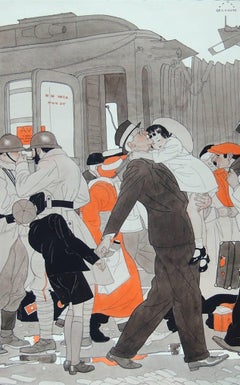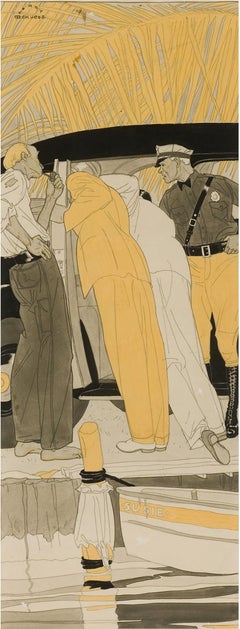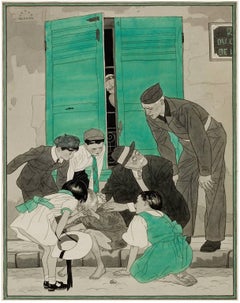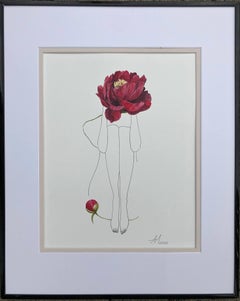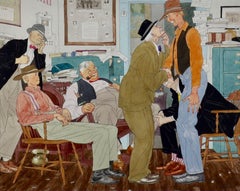Harry Beckhoff Art
to
2
1
Overall Width
to
Overall Height
to
3
1
1
3
2
2
1
1
1
1
1
1
3
3
2
1
1
3
10,083
2,779
1,379
1,375
2
3
Artist: Harry Beckhoff
After the Trip
By Harry Beckhoff
Located in Fort Washington, PA
Medium: Watercolor and Pen and Ink on Paper
Dimensions: 13.75" x 8.88"
Signature: Signed Upper Right
Exhibited:
Masters of the Golden Age: Harvey Dunn and His Students
South Dakota Art Museum, Brookings, South Dakota
May 5, 2015 - September 13, 2015
Norman Rockwell Museum...
Category
Mid-20th Century Harry Beckhoff Art
Materials
Paper, Ink, Watercolor, Pen
Searching the Car - Desaturated Colors Muted Warm Yellows and Grey
By Harry Beckhoff
Located in Miami, FL
This Harry Beckhoff illustration is masterfully rendered and intricately designed in line and wash. It's as abstract as it's representational with its graphic style, clean lines, and flat patterning. Every element in the composition works in harmony without a line out of place. The flat and abstract nature of the work rivals that of the great modernist painters of the 1930s.
Perhaps this was done for a major newsstand magazine like Collier's.
Although he studied with Dean Cornwell and Harvey Dunn, he didn't pursue the style of painterly brushstrokes and impastos. Instead, he defined his forms with flat shapes, whose internal forms are defined by thin lines. The emphasis is more on silhouette and line than it is on texture and lighting. Beckhoff also described his work as having been influenced by illustrators like Pierre Brissaud...
Category
1930s Harry Beckhoff Art
Materials
Watercolor, Illustration Board
Consolation, Collier's magazine illustration
By Harry Beckhoff
Located in Miami, FL
Signed upper left
Category
1940s Academic Harry Beckhoff Art
Materials
Gouache, Paper, Pencil
Related Items
Marguerite - 19th Century Pre-Raphaelite Painting of Beauty from Goethe's Faust
By Henry Meynell Rheam
Located in Gerrards Cross, GB
‘Marguerite’ by Henry Meynell Rheam RI (1859-1920). The painting is signed with monogram and dated. Watercolour and gouache on paper, newly remounted, glazed with non-reflective UV r...
Category
Late 19th Century Pre-Raphaelite Harry Beckhoff Art
Materials
Watercolor, Gouache
$8,190
H 24 in W 22 in D 3 in
Red peony - line drawing woman figure with flower
By Mila Akopova
Located in Fort Lee, NJ
Interior design paintings. The work was done with ink and watercolor on watercolor paper 300g. The work is 11 by 15 inches in size framed (black) with a styrene face on a double mat ...
Category
2010s Minimalist Harry Beckhoff Art
Materials
Paper, Ink, Watercolor
Neoclassical composition of a sculptor kneeling before his statue of the Madonna
Located in Middletown, NY
An allegory of loyalty, with the subject's dog pictured seated, holding his master's chisel in his mouth; fidelity personified.
Italian School, 18th century
Ink wash in gray and bl...
Category
Mid-18th Century Italian School Harry Beckhoff Art
Materials
Laid Paper, Ink, Watercolor
$500
H 9.73 in W 7.01 in
Georgian Contemporary Art by Ilia Balavadze - Hard Way
Located in Paris, IDF
Marker, ink, acrylic, pastel & watercolor on paper, Unstretched
Ilia Balavadze is a Georgian artist born in 1968 who lives and works in Tbilisi, Georgia. From 1987 to 1993, he studi...
Category
2010s Contemporary Harry Beckhoff Art
Materials
Pastel, Acrylic, Permanent Marker, Paper, Ink, Watercolor
$4,000
H 59.06 in W 78.75 in D 1.58 in
Study of a Seated Figure from Behind Pencil Sketch
Located in Cirencester, Gloucestershire
Study of a Seated Figure
pencil drawing on artist paper
painting: 11 x 8.25 inches
double sided
provenance: private collection, England
condition: very good and sound condition
Category
20th Century Impressionist Harry Beckhoff Art
Materials
Pencil
$109 Sale Price
20% Off
H 11 in W 8.25 in D 1 in
Tree and Courtyard - 20th Century Painting with Tree and Buildings
By James Lloyd
Located in Kingsclere, GB
Lloyd was born in Alsager, Cheshire, the son of a policeman who had taken up farming. He had worked on his father's farm until the age of 19, when he too joined the police force. Llo...
Category
20th Century Harry Beckhoff Art
Materials
Ink, Watercolor, Gouache, Pen, Pencil
$4,473
H 56 in W 36.5 in
Early 20th Century Young Golfer Figurative
By Margaret Neilson
Located in Soquel, CA
Study of a young man with his golf clubs by listed artist Margaret Neilson Armstrong (American, 1867-1944). Image, 14"H x 20"W. Displayed in vintage mat. S...
Category
1920s Realist Harry Beckhoff Art
Materials
Paper, Pencil
Self Portrait 02 - Modern Figurative Watercolor Painting, New Expressionism
By Maciej Olekszy
Located in Salzburg, AT
The artwork on paper will be sent unframed to you.
Maciej Olekszy was born in 1982, Poland. Graduated from the Academy of Fine Arts in Poznan, Poland in 2007. Faculty of Painting i...
Category
2010s Contemporary Harry Beckhoff Art
Materials
Paper, Watercolor
$1,441
H 41.34 in W 29.53 in
"Woman in a red dress in the garden full of roses"
Located in VÉNISSIEUX, FR
This woman in a red dress in the garden full of roses featured on the painting lost herself in the tender memories of a carefree childhood. She recalls the days when she was a littl...
Category
2010s Contemporary Harry Beckhoff Art
Materials
Paper, Oil
$540
H 11.82 in W 11.82 in D 0.04 in
Woman in a Dream. nr.1. Surrealist fantasy by spanish painter Antonio Monasterio
Located in Firenze, IT
Antonio Monasterio - Woman in a Dream. no.1
Technique: Mixed media on paper (pastels, wax, and pen)
Dimensions: Approximately 45 x 55 cm
Period: 1970s
This work presents an enigmatic...
Category
1980s Surrealist Harry Beckhoff Art
Materials
Paper, Wax Crayon, Ink, Tempera, Pen
$120 Sale Price
20% Off
H 19.69 in W 15.75 in
"Path to Joy" Portrait in Ink, Gouache and Acrylic on Paper with Deckle Edge
By Kevin Snipes
Located in Philadelphia, PA
"Path to Joy" is an original piece by Kevin Snipes made from ink, gouache, and acrylic on paper. This piece measures 19.5”h x 9.25”w and is signed en verso.
Kevin Snipes (he/him) is...
Category
21st Century and Contemporary Contemporary Harry Beckhoff Art
Materials
Paper, Ink, Acrylic, Gouache
$1,800
H 19.5 in W 9.25 in
Water Color Abstract - Figures at the Table
By Jean-Charles Lauthe
Located in Houston, TX
French painting in bright green, blue and yellow tones of someone sitting at a table by artist Jean-Charles Lauthe, 1971. Signed and dated lower right.
Original artwork on paper dis...
Category
1960s Abstract Harry Beckhoff Art
Materials
Watercolor, Paper
Previously Available Items
Men in Newspaper Office
By Harry Beckhoff
Located in Fort Washington, PA
Medium: Ink and Watercolor on Paper
Signature: Signed Lower Right
Category
Mid-20th Century Harry Beckhoff Art
Materials
Paper, Ink, Watercolor
Harry Beckhoff art for sale on 1stDibs.
Find a wide variety of authentic Harry Beckhoff art available for sale on 1stDibs. You can also browse by medium to find art by Harry Beckhoff in paint, watercolor, ink and more. Not every interior allows for large Harry Beckhoff art, so small editions measuring 7 inches across are available. Customers who are interested in this artist might also find the work of Edmund Darch Lewis, Emile Godchaux, and Ferdinand Victor Leon Roybet . Harry Beckhoff art prices can differ depending upon medium, time period and other attributes. On 1stDibs, the price for these items starts at $2,750 and tops out at $12,000, while the average work can sell for $2,900.
